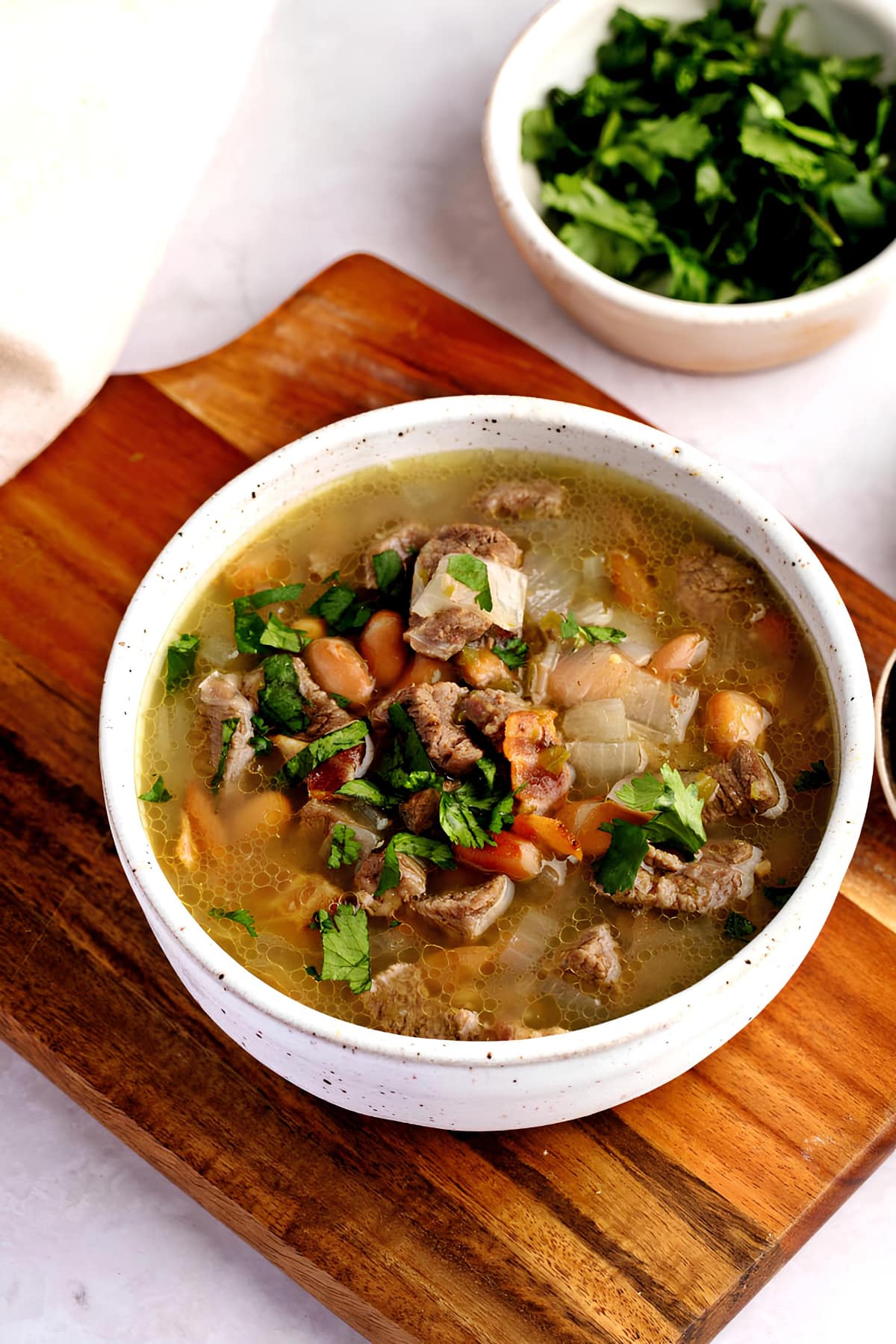Want to enjoy Mexican food with something besides the typical taco or burrito? Check out this recipe for carne en su jugo.
You won’t find it on many restaurant menus. But this beloved dish is traditional Mexican food at its finest. Directly translated as “meat in its juice,” carne en su jugo is a true delight for the senses.

It features tender beef simmered to perfection in a rich and savory broth.
There’s also a medley of other ingredients, including bacon, beans, and aromatic spices. Each spoonful tastes better than the last. Let’s check out this incredible recipe!
What Is Carne En Su Jugo?
As mentioned, “carne en su jugo” literally translates to “meat in its juice.”
It’s rich, savory flank steak simmered in its own yummy juices. There are a few other ingredients thrown in to make it healthier, heartier, and more delicious.
It’s a comforting, stick-to-your-ribs meal that’ll keep you full all night. It’s perfect when the weather turns cool.
Carne en su jugo is famous throughout Mexico, especially in Guadalajara, Jalisco. Try it once, and it’ll be just as popular in your house.

Ingredients
Here’s what you need to make this delicious, meaty dish.
- Bacon – Though you add the bacon in tiny crumbles, it still delivers a ton of flavor. Its smoky saltiness infuses every bite. Plus, it adds even more protein than the steak alone.
- Water and fresh tomatillos – Along with the steak’s juices, water and tomatillos make up the base for the stew. Fresh tomatillos have a bright, tangy flavor.
- Serrano peppers and garlic – Add these ingredients alongside the tomatillos and water. Together, they make an almost salsa-like base that tastes fantastic. You can use other chili peppers if you don’t have serrano.
- Flank steak – You can use a variety of beef cuts to make this stew. However, I like flank steak best. It’s tender and flavorful and doesn’t take hours to cook. Top-round sirloin is another good option.
- Chicken bouillon – Chicken bouillon adds a little extra flavor and savoriness to the broth.
- Pinto beans – Rich in fiber and high in protein, pintos add a lot to this recipe. They provide taste, texture, and plenty of extra nutrients. Plus, they make the stew more filling.
- Garnishes – Finish the recipe by topping each bowl with your favorite garnishes. Traditional ones include onions, cilantro, black pepper, and a lime wedge.
How to Make Carne En Su Jugo
This tempting dish couldn’t be easier to make. Follow these steps:
1. Prepare the bacon. Cook the bacon for about 10 minutes over medium-high heat, flipping occasionally. Then, allow it to cool and crumble it.
2. Make the sauce. Combine the water, tomatillos, serrano peppers, and garlic in a small saucepan. Heat over medium-high heat until the mixture begins to boil.
Then, add a lid and simmer the mixture for 10 minutes. After 10 minutes, allow it to cool, then puree it in a blender until it’s smooth.
3. Sear the steak. Cook the steak over medium-high heat until it browns completely.
4. Add the tomatillo mixture. Pour the tomatillo mixture into the skillet with the steak. Bring the mixture to a boil, then add the chicken bouillon. Reduce the heat, cover it with a lid, and simmer it for 30 minutes to an hour.
5. Warm the beans. Heat the pintos over medium heat. Then, keep them warm over low heat until you need them.
6. Combine the ingredients. Once the steak is ready, add the beans and the bacon into the same skillet as the steak. Stir until well mixed.
7. Garnish it and serve. Transfer the stew to serving bowls, and top each bowl with the garnishes. Serve, and enjoy!

Tips for the Best Carne En Su Jugo
Follow these tips and tricks for the very best stew.
- Give the beans a good rinse. If you don’t rinse and drain them, you can get an unpleasant paste-like taste. You don’t have to heat the beans separately if you rinse and drain thoroughly. Just add them to the skillet with the meat about 5 minutes before it’s done cooking.
- Dial up the flavor. Cook the tomatillos with chicken broth instead of water. This simple substitution provides a lot more flavor to the overall recipe.
- Season it up. If you want to season the meat, that’s fine! Sometimes, I season it with garlic, onion powder, a little cayenne, etc.
- Have fun and experiment. The garnishes listed here are traditional. However, you can add thin tortilla strips, shredded cheese, radishes, and more.
- Choose a sensational side dish. Serve it over or with a side of rice. You don’t have to do this, but the two pair well together.
Storage Tips
Here are your options for storing and reheating carne en su jugo:
- To Refrigerate: Allow your leftovers to cool completely. Then, transfer them (without the garnishes) to an air-tight container. Pop the container in the fridge, where they should keep for up to 4 days.
- To Freeze: Freezing your leftovers is another good option. Again, let the stew cool first. Then, transfer it to an air-tight, freezer-safe container. Be sure not to include the garnishes. Freeze it for up to 3 months.
- To Reheat: Heat it in the microwave on high heat for 30-second intervals. Stir it after every 30 seconds, then return it to the microwave for another 30 seconds. Continue until it’s heated through. If you’re reheating it on the stove, do so over low heat until it’s heated.
Remember to thaw frozen carne en su jugo in the fridge overnight before reheating it.












